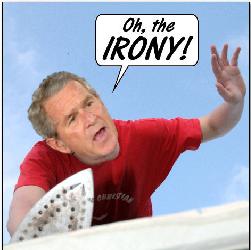Lesson 8: Rhetorical Tropes
Irony
 Irony is the most radical of the four main tropes.
As with metaphor, the signifier of the ironic sign seems to signify one thing
but we know from another signifier that it actually signifies something very different.
Irony is the most radical of the four main tropes.
As with metaphor, the signifier of the ironic sign seems to signify one thing
but we know from another signifier that it actually signifies something very different.
Where it means the opposite of what it says (as it usually does) it is based on binary opposition.
Irony may thus reflect the opposite of the thoughts or feelings of the speaker or writer.
Unless the ironic sign is a spoken utterance (when a sarcastic intonation may mark the irony) the marker of its ironic status comes from beyond the literal sign. A 'knowing' smile is often offered as a cue. In Britain a fashion for 'air quotes' (gestural inverted commas) in the 1980s was followed in the 1990s by a fashion for some young people to mark spoken irony - after a pause - with the word 'Not!', as in 'he is a real hunk - Not!'. However, irony is often more difficult to identify.
Here, for convenience, is a brief summary of the four tropes with some linguistic examples:
| Trope
| Basis
| Linguistic example
| Intended meaning
|
| Metaphor
| Similarity despite difference (explicit in the case of simile)
| I work at the coalface
| I do the hard work here
|
| Metonymy
| Relatedness through direct association
| I'm one of the suits
| I'm one of the managers
|
| Synecdoche
| Relatedness through categorical hierarchy
| I deal with the general public
| I deal with customers
|
| Irony
| Inexplicit direct opposite (more explicit in sarcasm)
| I love working here
| I hate working here
|
Class assignment (pair work, done orally):
Look at photos by Sharad Haksar
("Brand Irony" from http://freshpics.blogspot.com/2008/09/brand-irony-by-sharad-haksar.html) and comment upon the effect of irony.
Then watch two "Cadbury Ad" videos and consider the use of irony there. Can you classify it as "brand irony"?
Brand Irony
"Cadbury Ad 1"
"Cadbury Ad 2"
|
Resources for Lesson 8:
Chandler, Daniel. Semiotics for Beginners.
Student Essays (Daniel Chandler's course)
Richards, Ivor A (1932): The Philosophy of Rhetoric. London : Oxford University Press
Lakoff, George & Mark Johnson (1980): Metaphors We Live By. Chicago: University of Chicago Press
http://instructional1.calstatela.edu/laa/sign_4.html
http://www.dpchallenge.com/challenge_results.php?CHALLENGE_ID=421&page=1
http://tvtropes.org/pmwiki/pmwiki.php/Main/VisualPun
Wilden, Anthony (1987): The Rules Are No Game: The Strategy of Communication. London: Routledge & Kegan Paul
Lanham, Richard A (1969): A Handlist of Rhetorical Terms. Berkeley: University of California Press
Jakobson, Roman & Morris Halle (1956): Fundamentals of Language. The Hague: Mouton
|
Пермский государственный университет
|